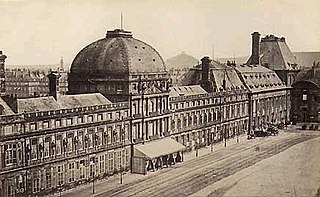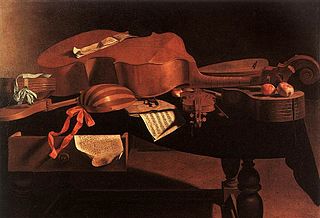Related Research Articles

Michel Richard Delalande [de Lalande] was a French Baroque composer and organist who was in the service of King Louis XIV. He was one of the most important composers of grands motets. He also wrote orchestral suites known as Simphonies pour les Soupers du Roy and ballets.

The Concert Spirituel was one of the first public concert series in existence. The concerts began in Paris in 1725 and ended in 1790; later, concerts or series of concerts of the same name occurred in Paris, Vienna, London and elsewhere. The series was founded to provide entertainment during the Easter fortnight and on religious holidays when the other spectacles were closed. The programs featured a mixture of sacred choral works and virtuosic instrumental pieces, and for many years took place in a magnificently-decorated Salle des Cent Suisses in the Tuileries Palace. They started at six o’clock in the evening and were primarily attended by well-to-do bourgeois, the lower aristocracy, and foreign visitors. In 1784 the concerts were moved to the stage area of the Salle des Machines, and in 1790, when the royal family was confined in the Tuileries, they took place in a Paris theater.

Jean-Joseph de Mondonville, also known as Jean-Joseph Cassanéa de Mondonville, was a French violinist and composer. He was a younger contemporary of Jean-Philippe Rameau and enjoyed great success in his day. Pierre-Louis Daquin claimed: "If I couldn't be Rameau, there's no one I would rather be than Mondonville".

Christophe Rousset is a French harpsichordist and conductor, who specializes in the performance of Baroque music on period instruments. He is also a musicologist, particularly of opera and European music of the 17th and 18th centuries and is the founder of the French music ensemble Les Talens Lyriques.

Les Arts Florissants is a Baroque musical ensemble in residence at the Théâtre de Caen in Caen, France. The organization was founded by conductor William Christie in 1979. The ensemble derives its name from the 1685 opera Les Arts florissants by Marc-Antoine Charpentier. The organization consists of a chamber orchestra of period instruments and a small vocal ensemble. Current notable members include soprano Danielle de Niese and tenor Paul Agnew, who has served as assistant conductor since 2007. Jonathan Cohen is also on the conducting staff; Christie remains the organization's Artistic Director.
Sandrine Piau is a French soprano. She is particularly renowned in Baroque repertoire although also excels in Romantic and modernist lieder and mélodies. She has the versatility to perform works from Vivaldi, Handel, Rameau to Schumann, Debussy, and Poulenc. She has made numerous studio recordings, primarily with Harmonia Mundi, Naïve, and Alpha since 2018.
The French musical ensemble Les Talens Lyriques was created in 1991 in Paris, France, by the harpsichordist and orchestral conductor Christophe Rousset. This instrumental and vocal formation derives its name from the subtitle of Les fêtes d'Hébé (1739) an opera by Jean-Philippe Rameau.

Henri Dumont was a baroque composer of the French school, born in the Southern Netherlands.
Jean Gilles was a French composer, born at Tarascon.
Agnès Mellon is a French soprano who specializes in baroque music.
La Chapelle Royale is a French ensemble of baroque music.
Hervé Niquet is a French conductor, harpsichordist, tenor, and the director of Le Concert Spirituel, specializing in French Baroque music.

Jean-Baptiste Lully was an Italian-born French composer, instrumentalist, and dancer who spent most of his life working in the court of Louis XIV of France. He is considered a master of the French Baroque style. Lully disavowed any Italian influence in French music of the period. He became a French subject in 1661.
Pierre Robert was a French composer and early master of the French grand motet.
The chapelle royale was the musical establishment attached to the royal chapel of the French kings. The term may also be applied to the chapel buildings, the Chapelle royale de Versailles.

Esprit-Joseph-Antoine Blanchard was a French baroque composer, a contemporary of Jean-Philippe Rameau, and regarded as a representative composer of religious music in eighteenth-century France.
Guillaume Minoret was a French baroque composer.
Joseph Michel (1679–1736) was an 18th-century French baroque chorister, composer and music teacher of the Sainte Chapelle of Dijon, demolished in 1802. A contemporary of Jean-Philippe Rameau, his reputation extended far beyond the boundaries of the city of Versailles and Burgundy.
Le Concert Spirituel is a French ensemble specialising in works of baroque music, played on period instruments. Founded by Hervé Niquet in 1987, it is named after the 18th-century concert series Concert Spirituel. The group performs internationally, playing mostly rarely performed sacred music and operas, and making recordings. Its focus is on French music played at the court of Versailles.
Sophie Daneman is a British soprano specializing in the baroque répertoire.
References
- ↑ Juan José Carreras López, Bernardo José García García, Tess Knighton The Royal Chapel in the time of the Habsburgs: music and ceremony 2005 p55 "Another characteristic of the grand motet - the initial intonation entrusted to a soloist - already existed in motets by Etienne Moulinié. Thus, the grand motet would consist of the accumulation of new and different elements (chorus, ..."
- ↑ Howard E. Smither A history of the oratorio 1977 p. 418 "The grand motet reveals Italian influence in its use of polychoral, concertato, and recitative styles;"
- ↑ Howard E. Smither A history of the oratorio 1977 p. 418 "Contributing to the image of brilliant majesty with which Louis XIV wished to be identified, these grands motets served to ..."
- ↑ James R. Anthony French Baroque Music: from Beaujoyeulx to Rameau 1997 p25
- ↑ James R. Anthony French Baroque Music: from Beaujoyeulx to Rameau 1997 p217
- ↑ Lorenzo Bianconi Music in the seventeenth century 1987 p150 "This extra-liturgical use of the grand motet is not anomalous, nor is it an eighteenth-century corruption of the ...
- ↑ François Martin, Mary Cyr Motets for one and two voices with instruments 1988 viii Historical Background "After the death of Louis XIV, the solemn magnificence of Lalande's large choral grands motets yielded to a gradual secularization."
- ↑ Anthony Lewis, Nigel Fortune Opera and church music, 1630-1750 1975 "The twelve grands motets of Jean- Joseph Mondonville (1711-72) make an apt end to the history of the grand motet in France. They were extravagantly praised when first heard at the Concert Spirituel in the 1740s..."